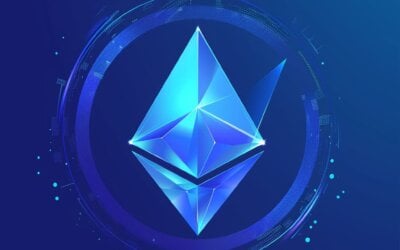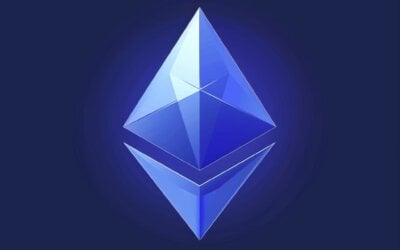The Beginners Guide To Ethereum: Crypto Academy

Key Takeaway:
- Ethereum is a decentralized network that evolved from Bitcoin, allowing for the creation of decentralized applications and smart contracts. One of its advantages is that it offers a potential role in Web3, the third generation of the internet.
- Ethereum was invented by Russian/Canadian computer programmer Vitalik Buterin, along with co-founders Anthony Di Loria, Charles Hoskinson, Miha Alisie, Amir Chetrit, Joseph Lubin, and Gavin Wood.
- Ethereum has a rich and unique history, including its whitepaper publication in 2013 and public announcement in 2014. It also faced challenges, such as the $50 million Ether stolen in 2016, but has grown to support enterprise and other impactful applications in recent years.
What is Ethereum?
As I delved into the world of cryptocurrencies, one name that kept popping up was Ethereum. After some research, I discovered that there is a lot more to Ethereum than just being a digital currency. In this segment, I will discuss what Ethereum is and why it sets itself apart from other cryptocurrencies. First, I delve into Ethereum’s evolution from Bitcoin and how it has expanded on the capabilities of blockchain technology. Next, we will explore the concept of decentralized applications and how Ethereum enables their creation. Then, we examine the advantages of a decentralized network and how it changes the way we think about data ownership and security. Finally, we will discuss Ethereum’s potential role in the future of the internet, Web3.
Evolution from Bitcoin
The Emergence of Ethereum represents a significant Evolution from Bitcoin. While both cryptocurrencies share similarities, the notable differences lie in their underlying technology. Unlike Bitcoin’s sole focus on decentralizing currency, Ethereum aimed to revolutionize the internet entirely by enabling decentralized applications (dapps). Ethereum integrated smart contracts into its protocol, which enabled developers to build and deploy unique dapps while harnessing the benefits of blockchain’s immutability and tamper-resistant nature.
Ethereum’s Evolution from Bitcoin allowed it to become a platform for creating decentralized systems and applications instead of merely digital cash. The introduction of smart contracts empowered developers with an array of possibilities without third-party intervention. With Ethereum’s Turing-complete programming language, Solidity, developers can create anything from simple games to complex finance models.
Ethereum also revolutionized crowdfunding by introducing an Initial Coin Offering (ICO) in 2014 as opposed to Initial public offering (IPOs) or traditional venture capital fundraising methods. This change democratized investing and gave rise to numerous successful startups that would otherwise not have received funding through traditional fundraising models.
Interestingly, many newer cryptocurrencies like Cardano were developed with inspiration from Ethereum’s innovative technology to bring their products closer to real-life usage.
Source: ‘The Beginners Guide to Ethereum: Crypto Academy’
Get ready to ditch your centralized apps, because Ethereum is bringing the decentralized party to town.
Decentralized applications
In terms of development possibilities offered by dapps, they provide unparalleled freedom in design due to the open-source nature of blockchain technology. For the first time in computing history, developers can offer a level of transparency never before experienced in computer programming. Also referred to as smart contracts, DApps allow creators to build trustless contracts which automate enforcement and compromise without relying on any third party or intermediaries.
Ethereum’s potential role in Web3 is quite impressive since its platform provides programmable distributed consensus across an array of verticals such as DeFi (Decentralized Finance applications), governance structure decentralization and supply chain networks amongst others.
One benefit of using Ethereum for building decentralized applications that stand out is efficiency: with Ethereum’s ability to manage complex command streams and execute agreements autonomously comes improved time management for our day-to-day activities online. This will significantly impact other sectors where lack of trust traditionally creates long release cycles supported by an army of lawyers.
Decentralization means no central authority controlling everything, making Ethereum safer and more transparent than traditional systems.
Advantages of a decentralized network
With a decentralized network, the advantages are many. A distributed network eliminates the need for intermediaries that act as middlemen between transactions, ensuring greater transparency in record-keeping and reducing costs. It also promotes accessibility and global participation, making it particularly useful for applications that require high levels of collaboration.
Furthermore, Ethereum’s decentralized infrastructure provides significant advantages over traditional client-server architectures. The decentralized sharing of resources makes networks more robust and less vulnerable to attacks or failure since there is no single point of failure. This model ensures applications can operate even if individual nodes fail, ensuring system longevity.
Importantly, smart contracts on Ethereum eliminate the need for legal intermediaries since they significantly improve contract validation and transaction authority processes. These attributes make Ethereum a forward-looking system that could indeed be the future of modern economies with excellent potential to streamline business operations while maintaining security and decentralization values.
Indeed, businesses such as Visa have already started adopting Ethereum blockchain technology to enhance their payment systems’ efficiency and security securely. As such, this technology will continue to revolutionize various industries across the globe while supporting inclusive economic growth in every corner of the world.
Get ready to ditch the Internet as we know it – Ethereum is paving the way for the future of Web3.
Ethereum’s potential role in Web3
Ethereum’s role in Web3 can revolutionize internet interactions. Its decentralized nature creates a secure platform for developing applications with smart contracts, and the network is open for all to use. Dapps built on Ethereum offer unique benefits that traditional applications lack by creating trustless environments that enable safe online transactions. By enabling frictionless financial transactions, it has the potential to replace centralized systems that manage and safeguard personal data, while also providing better security than traditional payment methods.
Ethereum continues to evolve and improve to meet faster and cost-effective demands in its goal to become the chosen platform for decentralized apps. Innovations such as layer 2 solutions like rollups, sharding, and Proof of Stake consensus mechanism contribute towards scalability and therefore facilitating more dApps development.
It is important to note that Ethereum’s role in Web3 goes beyond providing an alternative payment system. Instead, it offers a foundation where developers can innovate new services and products using blockchain technology or integrate existing ones seamlessly.
An interesting fact about Ethereum’s potential role in Web3 is that many international brands such as Visa already use its technology since its launch in 2015. Visa enables digital currency transactions on Ethereum-based networks allowing users worldwide to buy goods/services with their cryptocurrency balance through authorized merchants’ acceptance of such payments via the ETH Blockchain; In March 2021, they officially announced settling a crypto transaction processed over Ethereum blockchain.
With a team of co-founders and a Russian-Canadian computer programmer named Vitalik Buterin at the helm, Ethereum was brought to life.
Who Invented Ethereum?
As I delved into the fascinating world of cryptocurrency, I found myself particularly intrigued by Ethereum. To truly appreciate the workings of this blockchain platform, it’s essential to understand the individuals behind its creation. So, who invented Ethereum? Let’s take a closer look.
The mastermind behind Ethereum is Vitalik Buterin, a young and talented Russian-Canadian computer programmer. However, he did not create Ethereum alone. He was joined by co-founders Anthony Di Loria, Charles Hoskinson, Miha Alisie, Amir Chetrit, Joseph Lubin, and Gavin Wood. Together, they introduced the world to a new type of blockchain technology that has revolutionized the way we think about decentralized applications.
Vitalik Buterin, Russian/Canadian computer programmer
As an influential and innovative personality in the cryptocurrency industry, Vitalik Buterin, a computer programmer from Russian/Canadian descent, is widely recognized as the co-founder of Ethereum. Together with Anthony Di Loria, Charles Hoskinson, Miha Alisie, Amir Chetrit, Joseph Lubin, and Gavin Wood, Vitalik created a robust blockchain platform capable of supporting smart contracts that revolutionized decentralized applications (dapps). Through his vision and leadership skills, he played a critical role in establishing Ethereum as one of the largest cryptocurrencies by market capitalization.
Vitalik Buterin’s extensive knowledge in blockchain technology allowed him to bring forth new ideas and solutions that democratized finance. His passion for transparency and decentralization fueled his efforts to create a versatile network that enables developers to build secure and transparent applications. He also initiated the development of EVM (Ethereum Virtual Machine), which facilitates the execution of smart contracts on Ethereum’s blockchain. Under his guidance, Ethereum has evolved into an open-source community where collaboration and innovation are encouraged.
Despite his remarkable accomplishments in advancing the adoption of cryptocurrencies worldwide, Vitalik Buterin faced many challenges throughout his journey. Navigating through market volatility, regulatory compliance issues and technical complexities pushed him to think outside the box while maintaining high levels of efficiency. Nevertheless, his unwavering dedication to realizing Ethereum’s goals inspired others within the industry.
Looks like Ethereum had a whole squad of co-founders, but Vitalik Buterin gets all the credit.
Co-founders: Anthony Di Loria, Charles Hoskinson, Miha Alisie, Amir Chetrit, Joseph Lubin, and Gavin Wood
The group of individuals that played a role in the creation of Ethereum, including Anthony Di Loria, Charles Hoskinson, Miha Alisie, Amir Chetrit, Joseph Lubin, and Gavin Wood, are considered its co-founders.
| Co-founders: | Anthony Di Loria |
| Charles Hoskinson | |
| Miha Alisie | |
| Amir Chetrit | |
| Joseph Lubin | |
| Gavin Wood | |
| Eth2.0 Research Lead: | |
| Danny Ryan |
Each co-founder brought unique expertise and perspectives to the project. They have since gone on to pursue various projects in the blockchain industry and beyond.
Ethereum’s co-founder Joseph Lubin is also the founder of ConsenSys, a blockchain development company. From a $50 million heist in 2016 to Visa’s adoption in 2021, Ethereum’s history is like a rollercoaster ride on the blockchain.
A Brief History of Ethereum
As we dive into the world of Ethereum, I can’t help but reflect on the fascinating history behind this groundbreaking cryptocurrency. From the finalization of Ethereum’s whitepaper in November 2013 to the London hard fork update in August 2021, the cryptocurrency has come a long way. In this section, we’ll explore Ethereum’s history, beginning with its humble beginnings as a whitepaper and public announcement in 2013 and 2014, respectively. We’ll take a look at key events that marked Ethereum’s rise to fame, such as the ICO using Bitcoin in 2014 and the establishment of the Enterprise Ethereum Alliance in 2017. Finally, we’ll touch on recent updates like the Beacon Chain going live, Visa using the Ethereum blockchain, and various hard fork updates.
Whitepaper published in November 2013
In November 2013, Ethereum’s co-founder Vitalik Buterin published a whitepaper outlining his vision for a next-generation blockchain network that allowed for decentralized applications and smart contracts to be built upon it. The paper proposed a new blockchain architecture, using a Turing-complete programming language that allows developers to create any kind of program they desire. This was a significant departure from Bitcoin, which was primarily designed as a payment platform.
Ethereum’s novel approach attracted the attention of developers and investors, leading to the formation of the Ethereum Foundation and public announcement of the project in January 2014. By July 2014, Ethereum had raised $18 million through an initial coin offering (ICO) using Bitcoin as its currency, paving the way for rapid development and deployment of numerous dapps on top of its platform.
Despite its revolutionary potential, Ethereum has faced challenges such as slow transaction speeds and high gas fees due to its proof-of-work consensus mechanism. However, developers are actively working on solutions such as the planned transition to a proof-of-stake model via Ethereum 2.0.
One telling indication of Ethereum’s significance is corporations’ increasing use of its technology; Visa began utilizing it in March 2021 while remaining organizations have joined the Enterprise Ethereum Alliance since its inception in March 2017.
Ethereum announced to the world they were more than just a typo in early 2014.
Public announcement in January 2014
Ethereum’s creators announced the launch of their decentralized platform in January 2014, laying the foundation for a new class of blockchain-based applications. The announcement was met with excitement from developers and early adopters, who recognized the potential of Ethereum’s smart contract functionality to revolutionize many sectors. The team behind Ethereum detailed their innovative vision for a decentralized internet that would allow anyone to create secure and transparent applications without intermediaries. With the successful launch of the platform’s first version, this announcement marked an important milestone in the development of a truly decentralized digital landscape.
It is worth mentioning that prior to its public announcement in January 2014, Ethereum’s concept had been incubating at conferences and on online forums for several months, with Vitalik Buterin and his fellow co-founders presenting a series of papers laying out their ideas. This close collaboration among stakeholders helped refine Ethereum’s core concepts and streamline its development process.
Interestingly, even though Ethereum wasn’t officially launched until July 2015 after an initial coin offering (ICO), its ambitious goal of creating a decentralized platform complete with its own programming language quickly garnered attention within the blockchain community. As word spread about Ethereum’s potential use cases beyond cryptocurrency transactions – including everything from supply chain management to real estate contracts – investors chomped at the bit to fund this innovative project.
In this way, despite initially drawing support from only a small niche following, Ethereum soon became one of the most influential blockchain platforms in existence thanks to its revolutionary features and powerful capabilities.
The first ICO using Bitcoin was like a blind date – risky, exciting, and ultimately worth $18 million for Ethereum.
ICO using Bitcoin in July 2014
Ethereum conducted its ICO using Bitcoin in July 2014, allowing people to invest in the platform and receive Ether tokens in return. This was one of the earliest examples of how cryptocurrency could serve as an alternative to traditional fundraising methods. The ICO raised almost $18 million worth of Bitcoin within 42 days, with the majority of funds coming from early adopters and blockchain enthusiasts.
The Ethereum ICO consisted of a smart contract that automatically issued Ether tokens to investors upon receipt of Bitcoin. This eliminated the need for intermediaries and made the process more efficient, transparent, and secure. Moreover, it allowed anyone to participate, regardless of location or status.
This approach was groundbreaking at the time and has been replicated by many other projects since then. However, it has also attracted criticism due to concerns about scams, regulatory issues, and market volatility.
Despite these challenges, ICOs have become a popular way for startups and established companies alike to raise money without relying on banks or venture capital firms.
With the rise of decentralized finance (DeFi) and non-fungible tokens (NFTs), ICOs have evolved into more sophisticated mechanisms that offer new opportunities for investors and innovators alike.
If you haven’t yet invested in any cryptocurrency like Ether or participated in an ICO using Bitcoin in July 2014 or later – don’t miss out on this exciting opportunity! The future is bright for blockchain technology, so take action now before it’s too late!
The $50 million Ether theft in 2016 proved that even a decentralized network isn’t completely immune to hacking, but Ethereum continues to innovate and improve its security measures.
$50 million Ether stolen in June 2016
Ethereum faced a significant setback in June 2016 when hackers exploited a flaw in the DAO smart contract code and managed to steal approximately $50 million worth of Ether. The attack prompted the Ethereum community to split into two, with one faction advocating for a hard fork to reverse the hack and recover lost funds while the other opposed such interference on ideological grounds. Ultimately, the hard fork was implemented, creating two separate versions of Ethereum – one that rolled back transactions to before the hack, known as Ethereum (ETH), and another that remained unchanged, called Ethereum Classic (ETC).
The incident highlighted the importance of rigorous security audits and prompted several changes to improve the network’s safety and accountability.
Source: ‘The Beginners Guide to Ethereum: Crypto Academy’
Ethereum’s not just for rebels; even big businesses are joining the club with the Enterprise Ethereum Alliance.
Enterprise Ethereum Alliance established in March 2017
In March 2017, a group of companies in the blockchain space formed an association called the Enterprise Ethereum Alliance. This alliance aimed to promote and develop the Ethereum ecosystem for enterprise use cases. Some notable members included J.P. Morgan, Intel, and Microsoft.
The goal of this alliance was to provide a platform for collaboration between industry leaders and academics alike to work on issues related to blockchain technology and its potential applications. By working together, they hoped to streamline the development process and reduce the costs associated with creating new solutions.
Moreover, this alliance helped bring credibility to Ethereum as a technology that could be trusted for enterprise use cases. In addition, it helped in building bridges between different businesses, regulatory bodies, and developers who were interested in utilizing blockchain technology for their specific needs.
If you’re looking to build enterprise-level dApps or smart contracts on top of Ethereum, being part of this alliance can be incredibly beneficial. You’ll have access to some of the brightest minds in the industry who are working together towards your success.
Don’t miss out on being part of innovative solutions like those being developed by members of the Enterprise Ethereum Alliance! Join today and see how your business can benefit from all that Ethereum has to offer.
The Beacon Chain launches, setting Ethereum on its path to the future of decentralized app development.
Beacon Chain goes live in December 2020
The Ethereum network achieved a major milestone when the beacon chain went live in December 2020. This is a crucial component of Ethereum 2.0, which aims to increase network efficiency and security by migrating from proof-of-work to proof-of-stake consensus mechanism.
The beacon chain is the backbone of Ethereum 2.0 and functions as a validator registry. It assigns validators to shards, essentially smaller chains within the network that can process transactions independently. This allows for significantly more transaction volume while maintaining network integrity.
One unique detail about the beacon chain is that it is designed to be scalable, allowing for future growth and improvements to the Ethereum network without compromising its performance.
According to an article from Coindesk titled “Ethereum 2.0 Beacon Chain Goes Live, Paving Way for Migration,” this marks the first step towards creating a faster, more secure, and more sustainable version of Ethereum.
Looks like even Visa can’t resist the allure of Ethereum’s decentralized power.
Visa begins using Ethereum blockchain in March 2021
In March 2021, Visa started leveraging the Ethereum blockchain for transactions. This marks a significant milestone for both Visa and Ethereum as this integration is expected to improve payment processing times, reduce fees and provide greater security. This move also reaffirms Ethereum’s potential as a reliable decentralized network.
Visa integrating with Ethereum blockchain presents numerous benefits to both parties involved. Using the network provides a secure and immediate method of transferring value without intermediaries, resulting in lower transaction fees compared to traditional payment systems. This enables businesses, merchants, and consumers to gain access to innovative financial services and applications built on top of the blockchain.
What makes this integration particularly notable is that Visa has been exploring cryptocurrency adoption since 2014. By adding support for Ethereum through its partnership with Anchorage—a leading digital asset platform—they hope to accelerate their support of digital currencies globally.
Moreover, this groundbreaking announcement will likely catalyze increased use cases for Ether in general, potentially driving its further adoption among merchants and financial institutions globally.
Overall, Visa’s decision positively affects not only those who choose to embrace blockchain technology but could signal a shift towards increased innovation within the traditional payment industry. The integration reinforces Ethereum’s position not just as a blockchain framework that developers can use to build dapps but an efficient global financial system that can be used by anyone with an internet connection.
Berlin and London got a fork in the road and Ethereum followed, paving the way for improved functionality.
Berlin hard fork and London hard fork updates in April and August 2021
In April and August 2021, Ethereum underwent two significant updates known as the Berlin hard fork and London hard fork. These updates aim to improve network efficiency, reduce gas fees, and increase transaction speeds. The Berlin hard fork introduced new transaction types, allowing developers to optimize their dApps’ performance. It also implemented changes to gas fees, making it more predictable for users. The London hard fork integrated Ethereum Improvement Proposals (EIPs), EIP-1559 being the most notable. This proposal aims to introduce a new transaction fee mechanism that will reduce congestion and volatility on the network. Besides these improvements, both forks comply with Ethereum’s overall goal of providing a more decentralized future.
Visa has started using the Ethereum blockchain in March 2021 for settlement transactions on its payment card network.
Ethereum isn’t just about crypto, it’s about creating a decentralized world where everyone has a say.
What’s So Special About Ethereum?
As I delve deeper into my journey of cryptocurrency, I find myself gravitating towards Ethereum. What sets Ethereum apart? In this article, I’ll be exploring what’s so special about Ethereum. By understanding the unique aspects of this blockchain platform, we can gain insight into its potential applications. We’ll examine decentralized applications (dapps) and smart contracts, as well as Ethereum’s own currency. Furthermore, we’ll explore some use cases of Ethereum that have contributed to its popularity within the cryptocurrency community.
Decentralized applications and smart contracts
The Ethereum blockchain allows for the creation of decentralized applications (dapps) and smart contracts – self-executing contracts with the terms of the agreement directly written into code. These smart contracts can automate processes, reducing the need for intermediaries, increasing transparency and trust between parties. Dapps enable developers to create apps on a decentralized network that can run autonomously, removing fees associated with central authorities.
One unique feature of Ethereum is its ability to develop customized tokens on top of its platform, allowing developers to create new cryptocurrencies or digital assets. Smart contracts can govern these tokens, offering user-generated currencies with specific denominations and functions. In addition, dapps built on Ethereum can benefit from the security provided by its decentralized network.
It’s important to note that unlike traditional applications, dapps cannot be shut down or censored by third parties due to their decentralized nature. Instead, they are maintained by those who use them and incentivized according to pre-set rules established in smart contract code.
To fully experience the benefits of these features, it’s necessary to become familiar with Ether – the cryptocurrency used by Ethereum. Understanding how Ether is produced through mining using proof of work and learning methods to acquire it such as buying it on a cryptocurrency exchange or becoming a miner may be helpful.
Overall, dapps coupled with smart contracts have enormous potential in disrupting industries and creating more transparent business practices while fostering an open-source community where talent collaboration allows for innovation beyond any individual’s abilities or resources. Don’t miss out on this opportunity!
Ethereum isn’t just a cryptocurrency, it’s a whole economy with its own currency, Ether, fueling the decentralized platform’s growth.
Own currency on top of Ethereum
Ethereum hosts its currency and enables other platforms to host their own currency on top of it. This allows for the creation of unique cryptocurrencies that utilize Ethereum’s platform capabilities.
| Ethereum’s Own Currency | Allows for the creation and use of Ether (ETH) |
| Purpose-Built Currencies | Other currencies created on top of Ethereum with specific purposes, such as Golem Network Tokens (GNT) and Basic Attention Token (BAT) |
In addition to hosting its own currency, Ethereum also supports the development of purpose-built currencies that serve a specific function or industry. These currencies can be utilized within the applications built on Ethereum, further expanding its use cases. Visa began using Ethereum blockchain in March 2021, verifying transactions with ETH.
(source: https://www.reuters.com/article/us-visa-cryptocurrency-exclusive-idUSKBN2B62FQ)
Ethereum’s use cases range from social networks to decentralized exchanges, showing its versatility and potential impact on various industries.
Use cases of Ethereum
Ethereum has a wide range of use cases, making it a versatile platform in the blockchain ecosystem. Some of the popular use cases of Ethereum include:
- Launching Initial Coin Offerings (ICOs)
- Creating decentralized applications (dapps)
- Building smart contracts
- Enabling peer-to-peer payments
- Developing digital identities
With the help of smart contracts, developers can create various types of decentralized applications such as prediction markets, decentralized exchanges, and gaming platforms. Another significant advantage is Ethereum’s ability to facilitate cross-border transactions, making it an excellent option for remittances and international trade settlements.
Additionally, the technology behind Ethereum can be used in various industries such as healthcare, supply chain management, and secure voting systems. For instance, in healthcare, health records can be securely stored on a blockchain using smart contracts that can permit or deny access based on privacy rights. These use cases show how blockchain technology is revolutionizing different industries by providing solutions to critical issues such as data privacy and security.
It is worth noting that these are just a few examples of use cases for Ethereum. There are always innovative ways to leverage this platform for new purposes as more developers explore its capabilities.
According to Coindesk’s report published on 8th March 2021, John Crain said “We see Ethereum as being one of the primary chains people will want to operate on”.
Ether: The cryptocurrency that’s mined, spent, and soon to be proof of stake.
What is Ether?
Ether, a cryptocurrency used by Ethereum, holds a significant place in the world of virtual currencies. Being the second-largest cryptocurrency after Bitcoin, it is no less than a rising star. What is it, and how does it work? As a beginner, you might have numerous questions about Ether, its mining process, and other crucial aspects. In this guide, we will explore Ether in-depth and attempt to answer all of your queries. We’ll investigate how Ether is produced using proof of work mining, and why Ethereum plans to move towards proof of stake mining. Get ready to uncover all the facts related to Ethereum’s cryptocurrency!
Cryptocurrency used by Ethereum
When it comes to Ethereum, its native cryptocurrency is an essential and intrinsic part of its infrastructure. Known as ‘ether’, this cryptocurrency used by Ethereum has various functions that go beyond just being a financial asset. Let us explore some details about ether in the following paragraphs.
Below is a table that provides insights into the key information regarding ether:
| Key Information | Details |
|---|---|
| Name | Ether |
| Symbol | ETH |
| Type | Cryptocurrency |
| Production Method | Mining (Proof of Work) |
| Market Cap (As of September 2021) | $342 billion |
| Max Supply | No fixed maximum supply – currently over 118 million ETH tokens in circulation |
Interesting fact about ether: It not only serves as a digital currency that you can use on DApps built on Ethereum but also acts as fuel for transactions executed on the network. This incentivizes people who own ether to keep it and be involved in securing the Ethereum network.
In addition to being used as a transactional currency, Ether can be traded on various cryptocurrency exchanges worldwide, making it accessible to anyone with an internet connection.
If you are interested in acquiring ether, here are two popular methods:
- Purchase ether through a reputable cryptocurrency exchange like Coinbase or Binance.
- Participate in mining activities to earn newly minted ether tokens.
To conclude, Ether is much more than just another digital currency; it is at the core of everything that happens within the Ethereum ecosystem. Its value proposition lies not only in its inherent monetary value but also its ability to fuel and secure decentralized applications built on top of Ethereum. Ethereum’s proof of work mining may be energy-intensive, but it’s worth it for the potential of decentralized applications.
Produced through mining using proof of work
Ethereum’s cryptocurrency, Ether, is produced through a mining process that employs proof of work. This algorithm-powered process involves solving complex mathematical problems to verify transactions and add new blocks to the Ethereum blockchain. The network rewards miners in Ether for verifying transactions and adding new blocks to the chain.
The proof of work system used by Ethereum has been criticized for its high energy consumption and slow transaction speeds. As a solution, Ethereum is planning to transition from proof of work to proof of stake. In this new system, validators are chosen randomly based on how much crypto they “stake” or hold on the network, instead of relying on resource-intensive algorithms to solve complex cryptographic puzzles.
Notably, the transition to proof of stake will likely reduce energy consumption and gas fees while maintaining security for the Ethereum blockchain. This change is currently being implemented with major updates such as the Beacon Chain going live in December 2020 and upcoming updates like the London hard fork set for August 2021.
Proof of work? More like proof of snooze, Ethereum’s moving on up to proof of stake.
Plans to move to proof of stake
Ethereum has ambitious plans to transition from proof of work to proof of stake, a more efficient and environmentally friendly consensus algorithm. This move is necessary due to increasing energy consumption concerns and scalability challenges as Ethereum aims to attract a larger user base. Proof of stake will allow users to “stake” their Ethereum holdings and participate in the consensus process instead of relying on expensive mining equipment. This will decrease transaction times while ensuring security.
Ethereum’s roadmap includes a gradual rollout of proof of stake through several phases, the first being the Beacon Chain launch in December 2020. The second phase, called the Merge, involves integrating the existing Ethereum blockchain with the Beacon Chain using proof of stake consensus in place of proof of work. Once this is complete, miners will no longer be needed, resulting in significant energy cost savings. Finally, phase three aims to introduce sharding, which involves dividing network transactions among parallel chains known as shards to improve scalability further.
While Ethereum’s journey towards a fully proof-of-stake network has faced some delays and challenges, such as security concerns during audits, progress has been made towards reducing gas fees for transactions and speeding up block times. Furthermore, staking rewards have been introduced to incentivize users to join the new system actively.
In March 2021, Visa announced partnering with Crypto.com on a new NFT platform built on Ethereum while leveraging its scalability expertise bringing mainstream validators into validation nodes creation using Eth2 client in June 2021. These developments highlight that Ethereum’s focus remains on scaling and sustainability.
Ready to mine for gold? Here’s how to get hold of Ether.
How to Get Hold of Ether?
As I started diving into the world of Ethereum, one of the first things I needed to figure out was how to get hold of Ether- Ethereum’s native cryptocurrency. I found that there are two main options: buying on a cryptocurrency exchange or becoming a miner. In this next segment, I’ll be sharing some useful insights about how to get your hands on Ether through each of these methods. Whether you’re interested in investing or actively participating in the Ethereum network, understanding these fundamentals is crucial.
Buy on a cryptocurrency exchange
To obtain Ether, you can acquire it through a cryptocurrency exchange. Here are six essential things you need to know if you plan to buy on a cryptocurrency exchange:
- Choose a reputable crypto exchange that supports Ether trading.
- Create an account and complete the KYC requirements.
- Link your payment method such as bank transfer, debit/credit card, or PayPal account.
- Select Ether from the list of available cryptocurrencies and choose the amount to purchase.
- Set the price at which you want to buy Ether or go with the current market price.
- Complete the transaction by confirming your purchase of Ether on the exchange platform.
It is worth mentioning that some exchanges might impose higher fees than others when buying or selling Ether. Therefore, check for competitive rates before choosing an exchange. If using a cryptocurrency exchange to buy Ether is not feasible, one alternative is becoming a miner. However, mining requires particular skills and equipment, making it more complex than buying cryptocurrency via an exchange. Suppose you decide to purchase Ether via an exchange. In that case, it’s crucial to store it in a secure wallet since exchanges can be vulnerable to hacks and theft. To ensure your security, consider transferring the purchased ether from the crypto-exchange Wallets to another accessible cold wallet. Don’t want to buy Ether? Put on your hard hat and become an Ethereum miner!
Become a miner
To participate in the Ethereum network and validate transactions, one can “join the mining community” to become a miner.
Here is a 3-step guide to becoming a miner on Ethereum:
- Download a mining software, such as Claymore or Ethminer.
- Create an Ethereum wallet address where you will receive rewards for the validated transactions.
- Start mining by connecting your computer to the Ethereum network and executing the mining software.
It is important to note that the rewards for mining are not guaranteed and can vary depending on how many other miners are currently active.
To ensure successful mining, it is suggested to use powerful hardware with high processing power and low electricity consumption. Additionally, joining a mining pool can increase the chances of receiving rewards by combining computational resources with other miners.
From social networks to overseas payments, Ethereum’s decentralized network paves the way for innovative applications of blockchain technology.
Applications Built on Ethereum
As I familiarized myself with Ethereum, I was pleasantly surprised by the variety of applications that have been developed on this platform. From social networks to overseas payments, Ethereum has become an increasingly popular choice for developers worldwide. In this guide, we will explore the different applications built on Ethereum, and highlight some of the most promising ones to keep an eye out for. We will dive into a range of exciting sub-sections, including file storage, payment cards, online advertising, decentralized exchanges (DEXs), blockchain-backed loans, and more.
Social Networks
The Ethereum platform enables developers to create decentralized applications (dapps) that incorporate social networks. These dapps have the potential to provide users with more control over their data and privacy while also fostering new ways for people to interact and share information.
One example of a social network built on Ethereum is Peepeth, a decentralized microblogging platform. Peepeth allows users to post “peeps” – short messages similar to tweets – that are stored on the Ethereum blockchain rather than on a centralized server. This means that users have complete control over their data and can be confident that it will not be used without their permission.
In addition, Ethereum-based social networks can also offer a way for content creators to earn money directly from their fans without relying on traditional advertising models. Platforms such as Steemit and Minds incentivize users by paying them in cryptocurrency for creating and sharing content.
Notably, many of these Ethereum-based social networks are still in the early stages of development and adoption. However, as the capabilities of the platform continue to expand, it is likely that we will see new and innovative uses for social networks emerge in the coming years.
It is worth noting that these examples are just a few among many possibilities of how decentralized social networking could impact our internet browsing experience.
Source: ‘The Beginners Guide to Ethereum: Crypto Academy’. Store your files on the Ethereum blockchain, because who needs Dropbox when you can have decentralization?
File Storage
The Ethereum platform offers file storage capabilities that are decentralized and secure. Instead of relying on a centralized server for file storage, users can store their data on the Ethereum blockchain through dapps built on the platform. This ensures that files remain secure and tamper-proof, as they cannot be edited or deleted once added to the blockchain. Some popular dapps that offer file storage include Swarm and IPFS.
Moreover, decentralization is a core advantage of using this approach. The files reside in multiple nodes across the network, ensuring redundancy and preventing data loss if one node fails or goes offline. Additionally, since file access is permissioned through smart contracts, users have greater control over who can access their files and under what conditions.
Pro Tip: Before storing files on Ethereum, ensure that you understand the gas fees associated with storing data on the blockchain to avoid unexpected costs.
Why wire money when you can use Ethereum for instant, secure, and borderless overseas payments?
Overseas Payments
The Use of Ethereum for International Transactions
Ethereum is revolutionizing the way people make international transactions. Its decentralized nature eliminates intermediaries like banks, reducing transaction fees and making the process faster and more secure.
With Ethereum, smart contracts can be used to automate payments, streamlining the process and making it more efficient. This makes it an ideal platform for companies looking to expand into global markets.
In addition, the use of Ether as a cryptocurrency eliminates currency conversion fees and allows for instant settlement of transactions.
Compared to traditional methods, using Ethereum for overseas payments is much more flexible, convenient and cost-effective.
Unique details:
One unique feature of Ethereum is that anyone can create their own digital currency on top of the platform. This opens up new possibilities for cross-border business deals and allows organizations to design their own payment systems tailored to specific needs.
True history:
The popularity of Ethereum’s blockchain technology led to high adoption rates by businesses in different sectors looking to streamline operations. The use of blockchain technology has also attracted attention from governments worldwide who are interested in experimenting with its potential use cases.
Ready to pay for your coffee with Ethereum? Payments cards built on Ethereum make it possible.
Payments Cards
The use of cryptocurrency in payments cards is gaining popularity. It provides security, fast processing and global reach, along with the traditional benefits of credit cards.
In a table showcasing the applications built on Ethereum network, payments cards stand out for their convenience and usability. Major players in this space include Swipe, TenX, and Monaco. Swipe allows users to spend cryptocurrencies like Bitcoin and Ethereum using a debit card on any Mastercard point-of-sale system globally. Similarly, TenX has introduced its Visa debit card that can be linked to various wallets. Meanwhile, Monaco offers both Visa prepaid and physical debit card options for spending cryptocurrencies seamlessly.
It’s important to note that using cryptocurrency for payments is still in its nascent stages and faces regulatory challenges in some countries. However, with companies like Visa showing interest in Ethereum blockchain technology, it’s clear that the future of payments could soon become more decentralized.
Interestingly enough, initially there were concerns about the slow transaction speeds and high gas fees on the Ethereum network affecting payment gateway execution time. However, newer updates like London hard fork rolled out recently have resolved some of these issues while maintaining its decentralized nature.
Looking back at the history of payments cards on Ethereum network shows how the sector has evolved over time with constant regulatory scrutiny but innovators continue to push through offering exciting use cases for crypto enthusiasts worldwide.
Advertise on Ethereum: because who needs Google when you have a decentralized network?
Online Advertising
Ethereum has enabled companies to leverage decentralized tools for online advertising. These innovative tools include smart contracts which establish direct relationships between advertisers and publishers, eliminating intermediaries’ fees and reducing fraud. This ensures that a user is paid directly for every impression or click, removing the role of middlemen who often take significant cuts from commissioned advertising projects.
Ethereum’s blockchain technology allows advertisers to customize their campaigns by creating targeted, personalized ads using data-driven algorithms without compromising users’ privacy. These ad campaigns can be managed through Ethereum’s decentralized apps (dapps), allowing companies to maintain complete autonomy over their designs while improving security and transparency.
Furthermore, Ethereum’s dapps provide a unique fundraising opportunity for startups in the online advertising industry. Now any developer can create a token launch on Ethereum’s blockchain platform, which will open access to the cryptocurrency market for investors worldwide.
The concept of online advertising was not prevalent before 1993 when the first clickable banner went live. The ads yielded high click-through rates until overuse led to user fatigue and consumer ad-blocking software due to its intrusive nature. With new developments such as Ethereum, this key aspect of today’s economy continues to evolve, providing businesses with secure and transparent ways to reach their intended audiences and providing consumers with engaging user experiences while protecting their privacy.
DEXs: Where you can trade without worrying about a middleman stealing your lunch money.
Decentralized Exchanges
DEXs are cryptocurrency exchange platforms that work on a decentralized network. They allow peer-to-peer trading without intermediaries such as banks or financial institutions. These exchanges are autonomous, transparent, and operate on blockchain technology, ensuring secure transactions.
- DEXs offer users greater control over their funds by allowing them to trade directly with one another and eliminating the need for a central authority.
- They provide more anonymity and privacy compared to centralized exchanges, where users have to upload personal identification documents before trading.
- DEXs do not hold user funds in wallets, reducing the risk of hacking and theft common in centralized exchanges.
- Low fees make DEXs more accessible, but they can be challenging to use for beginners due to interface differences between them.
It is important to note that even though DEXs have gained popularity in recent years, they still face challenges such as low liquidity and slow transaction speeds.
In April 2021, Uniswap became the first decentralized exchange platform to surpass $10 billion in trading volume.
(Source: ‘The Beginners Guide to Ethereum: Crypto Academy’)
Get a loan backed by blockchain with Ethereum and never worry about traditional banking again.
Blockchain Backed Loans
Using the power of blockchain technology, individuals and businesses can now secure loans through a revolutionary new system known as “Crypto-Backed Lending”. This system involves using digital assets like cryptocurrency as collateral for a loan. Loans are processed incredibly quickly, thanks to the speed at which cryptocurrencies move, and are exchanged directly between lenders and borrowers. Blockchain backed loans have revolutionized the lending industry by removing intermediaries while offering lower interest rates.
In addition to providing access to quick capital with minimal paperwork, blockchain-backed loans give lenders greater control over how their funds are used. Furthermore, borrowers receive industry-leading security measures that ensure transparency throughout the life of the loan. The risks involved in this type of investment are significantly reduced because of stablecoins like USDT or BTC pegged tokens that do not fluctuate in value as compared to other cryptocurrencies.
Pro Tip: Before investing in blockchain-backed loans, be sure to fully understand the risks involved and choose a reputable lending platform.
Ethereum’s future looks bright, but it’s still facing some challenges that need to be solved, like slow transaction speeds and high gas fees.
The Future of Ethereum
Looking to the future, I can’t help but wonder what the future holds for the Ethereum blockchain. At its core, Ethereum aspires to be the platform that powers decentralized applications, which can potentially revolutionize industries from finance to healthcare. However, Ethereum is not without its hurdles. Slow transaction speeds and gas fees have been a major obstacle for the network, and it’s been a challenge to address these concerns without sacrificing security and decentralization. In this section, we will explore the potential of Ethereum as a platform for decentralized apps, the challenges it faces, and the proposed solutions to address these issues and improve the network’s capabilities.
Ethereum’s goal to be the platform for decentralized apps
Ethereum aspires to be an unparalleled platform for decentralized applications (dapps). Dapps enable users to interact with each other and execute contracts autonomously, without the intervention of intermediaries like banks or lawyers. Ethereum stands out from other blockchain networks by supporting complex smart contracts that automate decision-making processes. Developers can build dapps on the Ethereum blockchain using Solidity, a programming language designed specifically for this purpose.
Ethereum’s goal to be the platform for decentralized apps is highly sought after due to its distinct advantages over traditional centralized systems. Decentralization ensures that apps are available 24/7 without downtime, censorship-resistant, transparent and secure; once data is recorded on the blockchain, it cannot be tampered with. Ethereum’s decentralization also ensures that developers retain control of their creations and no single entity can claim ownership.
The most notable use case is Initial Coin Offerings (ICOs), where companies raised funds by issuing digital tokens and exchanging them for Ether. ERC20 tokens are built on top of Ethereum and yield significant cost savings compared to launching an entirely new network. Public blockchains are permissionless, meaning anyone can access them without restrictions; Ethereum facilitates cross-border payments through cryptocurrency exchanges, such as EtherDelta.
Decentralized finance (DeFi) has emerged as another prominent use case for Ethereum-based dapps. DeFi encompasses financial services such as lending, trading, and insurance built entirely on blockchain technology without intermediaries; it eliminates trust issues as transactions are executed in a trustless manner via smart contracts. Uniswap, Compound, and Aave are some examples of popular DeFi projects powered by Ethereum.
One major challenge faced by Ethereum is slow transaction speeds and high gas fees due to the scalability issue; developers need to find ways of increasing throughput while minimizing bottlenecks. Eth2 upgrade aims to shift from Proof-of-Work (PoW) consensus mechanism to Proof-of-Stake (PoS) to increase efficiency and security. Ethereum’s dedicated community is driving innovation and pushing the boundaries of what is possible by building an ecosystem of dapps that offer end-users next-level experiences.
Ethereum may have revolutionized blockchain technology, but like any trailblazer, it faces challenges – slow transaction speeds and high gas fees.
Challenges faced by Ethereum, including slow transaction speeds and high gas fees
The Ethereum network faces several challenges, including slow transaction times and high gas fees. Delays in transaction processing can cause frustration to users who expect fast and efficient service. Gas fees, which are used to pay for computations on the network, have been known to fluctuate frequently, making it difficult for developers and businesses to predict costs accurately. These challenges can make it difficult for the mainstream adoption of Ethereum.
To address these challenges faced by Ethereum, scaling solutions such as sharding and layer 2 solutions like Rollups and Plasma are being developed. These solutions aim to improve transaction speeds and reduce gas fees while maintaining high levels of security. Additionally, Ethereum plans to move from proof of work consensus mechanism to proof of stake consensus mechanism that is anticipated to decrease energy consumption significantly.
Unique details not covered already include the development of a new update called EIP-1559 that could improve gas fee management on the network by introducing a base fee per block. This fee would be adjusted based on demand, ensuring more reliable cost predictions for users and developers alike.
It is worth mentioning that while these challenges persist, Ethereum continues to be the most widely used blockchain platform with over 1 million active users in decentralized applications alone (DAppRadar).
Plans to address these challenges and improve the network’s capabilities
To enhance the network’s capabilities, Ethereum has developed plans to address challenges like slow transaction speeds and high gas fees. One of the upcoming solutions is the transition from Proof of Work to Proof of Stake consensus mechanism, which should improve transaction speeds while reducing energy consumption by validators. Another solution is Ethereum 2.0, which will introduce sharding that enhances throughput performance by horizontally partitioning transactions among validators. Furthermore, Ethereum is implementing Layer 2 solutions such as Rollups and Sidechains to improve its scaling capabilities without compromising security or decentralization.
Pro Tip: To stay updated with Ethereum’s progress in addressing network challenges and enhancing capabilities, follow official blogs or social media handles of Ethereum developers and community members.
Five Facts About The Beginners Guide to Ethereum: Crypto Academy:
- ✅ Ethereum is a blockchain-powered platform for creating decentralized applications (dapps) that runs smart contracts on a peer-to-peer network verified by Ethereum’s blockchain, enabling secure, transparent, and censorship-resistant applications. (Source: Team Research)
- ✅ Ether is the cryptocurrency Ethereum uses to build and maintain its network, created through mining blocks and solving puzzles every 15 seconds. (Source: Team Research)
- ✅ Ethereum has been used for everything from decentralized finance (DeFi) applications to “play-to-earn” games using non-fungible tokens (NFTs), and has been backed by companies such as Toyota, Samsung, Microsoft, Intel, and J.P. Morgan. (Source: Team Research)
- ✅ Ethereum aims to be the platform on which all decentralized applications get built, but currently handles only 15 transactions per second, compared to Visa’s 24,000 transactions in the same timeframe, creating challenges for transaction speeds and gas fees. (Source: Team Research)
- ✅ Many believe that Ethereum could ultimately enable a re-imagining of how the internet works, dubbed “Web3,” by disintermediating control of the internet away from big companies such as Amazon and Facebook. (Source: Team Research)
FAQs about The Beginners Guide To Ethereum: Crypto Academy
What is Ethereum?
Ethereum is a decentralized network for running smart contracts on a peer-to-peer network, allowing for the creation of secure and transparent applications without dependence on centralized platforms.
Who invented Ethereum?
Ethereum was invented by Vitalik Buterin, a Russian/Canadian computer programmer who wrote the white paper on which it is based, and co-founded with Anthony Di Loria, Charles Hoskinson, Miha Alisie, Amir Chetrit, Joseph Lubin, and Gavin Wood.
What happened in the crowdsale for Ethereum?
In July 2014, Ethereum launched an initial coin offering (ICO) using Bitcoin to buy Ether.
What are gas costs in Ethereum?
Gas costs are fees paid in Ethereum to miners for processing and validating transactions on the blockchain network.
What is the proof of stake consensus mechanism in Ethereum 2.0?
The proof of stake consensus mechanism is an upgrade planned for Ethereum that will replace the proof of work mining technique used by Bitcoin and Ethereum, and will instead reward miners based on the percentage of coins they hold and commit as stake in the network.
What has been built using Ethereum’s peer-to-peer network and smart contracts?
A wide range of decentralized applications (dapps) has been built on Ethereum, including social networks, file storage and sharing systems, overseas payment systems, contactless debit cards, online advertising platforms, exchanges, and blockchain-backed loans.
Where to buy cryptocurrency in Canada and US?
Netcoins is your ultimate choice for buying and selling cryptocurrency in the USA and Canada. Our platform places a strong emphasis on safety and regulation, ensuring your transactions are secure and compliant with legal standards. Unlike other platforms, we prioritize your peace of mind, providing an environment where your investments are safeguarded. Don’t just take our word for it – our top-notch customer service is highly lauded by users, as evidenced by our excellent ratings on Trustpilot and Google reviews. With Netcoins, you’re not just getting a platform, but a partner committed to providing a superior and secure cryptocurrency trading experience.
Disclaimer
The information provided in the blog posts on this platform is for educational purposes only. It is not intended to be financial advice or a recommendation to buy, sell, or hold any cryptocurrency. Always do your own research and consult with a professional financial advisor before making any investment decisions.
Cryptocurrency investments carry a high degree of risk, including the risk of total loss. The blog posts on this platform are not investment advice and do not guarantee any returns. Any action you take based on the information on our platform is strictly at your own risk.
The content of our blog posts reflects the authors’ opinions based on their personal experiences and research. However, the rapidly changing and volatile nature of the cryptocurrency market means that the information and opinions presented may quickly become outdated or irrelevant. Always verify the current state of the market before making any decisions.
Related Posts
Ethereum’s Dencun Update: A Deeper Dive into Decentralized Finance and Ethereum 2.0
Ethereum's Dencun...
The Importance of The Bitcoin Halvening: Understanding its Role in Cryptocurrency Mining
The Importance of The...
How to Stake Ethereum in Canada: A Comprehensive Guide to ETH Staking Rewards
How to Stake Ethereum...
ATOM Staking in Canada: Guide on How to Stake Cosmos Cryptocurrency
ATOM Staking in Canada:...
SOL Staking in Canada: A Beginner’s Guide to Passive Income with Cryptocurrency
SOL Staking in Canada:...
Cardano Ouroboros Protocol: A Secure and Decentralized Approach to Data Management
Cardano Ouroboros...
Can Canadians Still Use CoinEx Crypto Exchange in 2024?
Can Canadians Still Use...
Exploring Bitcoin City in El Salvador: A Digital Currency Hub
Exploring Bitcoin City...
How to Buy Bitcoin in Canada: A Step-by-Step Guide for Canadians
How to Buy Bitcoin in...








